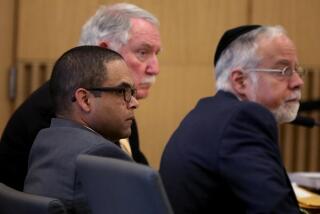Judge allows George Zimmerman school records into evidence
The prosecution in the George Zimmerman murder case introduced his school and medical records into evidence Wednesday, a move aimed at showing that the neighborhood watch volunteer was familiar with self-defense law and had hopes of a career in law enforcement.
In an interview last year with Fox News’ Sean Hannity, Zimmerman said he did not have knowledge of self-defense law.
Zimmerman, 29, is charged with second-degree murder in the shooting of Trayvon Martin, an unarmed African American teenager, during a confrontation on Feb. 26, 2012, in a gated community in Sanford, Fla. Zimmerman says he shot Martin in self-defense.
PHOTOS: The controversial case in pictures
Judge Debra S. Nelson on Wednesday ruled in favor of a prosecution motion to admit Zimmerman’s school records, his job application to a Virginia police agency and his request to the Sanford police to go on a ride-along with officers.
The defense had argued that the records were irrelevant to what happened on the rainy night when Zimmerman and Martin had their clash.
The prosecution is hoping the records and applications will support the theory that Zimmerman was a wannabe cop who became increasingly frustrated by incidents of crime in his gated community. When Zimmerman saw Martin, the prosecution maintains, the neighborhood watch volunteer profiled the teenager, followed him and then had a confrontation that led to Martin being shot to death.
Zimmerman “has applied to be a police officer before, he still wants to be one; according to some of his homework assignments ... this wasn’t some sort of passive thing,” prosecutor Richard Mantei said in arguments Wednesday.
Mantei also said Zimmerman took a course on how to be a good witness.
GRAPHIC: Who’s who in the Trayvon Martin case
Defense attorney Mark O’Mara referred to the prosecution’s efforts to introduce the documents as “a witch hunt.” O’Mara said that if prosecutors start bringing up Zimmerman’s past, the defense will seek to dig into Martin’s past.
“We have taken pains not to get into Trayvon Martin’s school records,” O’Mara said on Tuesday and repeated on Wednesday. He argued that allowing the Zimmerman records into evidence could open the door to the defense to bring in Martin’s history, including incidents of fighting.
Nelson said she didn’t want to hear arguments on the Martin issue at this point.
After Nelson’s ruling, the jury entered the courtroom and heard from Army Capt. Alexis Francisco Carter, who taught the course that Zimmerman took at Seminole State College. Zimmerman “was probably one of the better students in the class,” earning an “A,” Carter said.
He went on to say that that Florida’s “stand your ground” self-defense law was a frequent topic of discussion in the class. “I remember talking about it quite a few times,” Carter said.
On cross-examination, defense attorney Don West questioned Carter about self-defense law as he taught it. The questioning was part of an effort to show the jury how the defense’s theory of self-defense was supported. Zimmerman has said he was repeatedly hit by Martin, but the prosecution counters that the injuries were minor, implying that Zimmerman was not being accurate.
Carter testified that injuries aren’t required for a valid self-defense claim, but that they can support the premise that a person had a “reasonable fear” of harm or death. A situation can turn deadly very quickly, he said. “Things can change in a matter of moments.”
Jurors also briefly heard from Jim Krzenski, the administrator of the Sanford Police Department, who testified that Zimmerman in 2010 had sought a ride-along with police to help solidify his “chances of a law enforcement career.”
Amy Siewert, a Florida Department of Law Enforcement firearms analyst, was the last witness to testify before lunch. She exhibited the 9-millimeter semiautomatic handgun that Zimmerman carried, and testified that Zimmerman had a full magazine and a bullet in the chamber when he fired the shot that killed Martin.
On cross-examination, she agreed that the gun was safe to carry fully loaded and that it wouldn’t fire unless the trigger is pulled. It is not unusual for someone to carry this type of gun fully loaded, she said.
ALSO:
Surviving hotshot at Arizona fire was the lookout
Ariel Castro is competent for trial in kidnap-rape case
Movie industry tries recycling set props: ‘Green is sexy’
More to Read
Sign up for Essential California
The most important California stories and recommendations in your inbox every morning.
You may occasionally receive promotional content from the Los Angeles Times.











